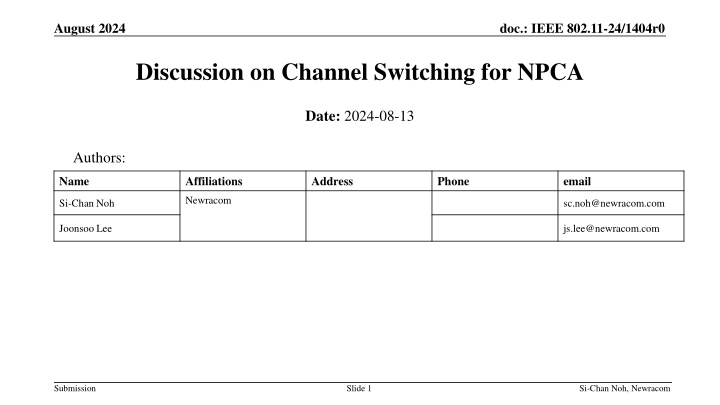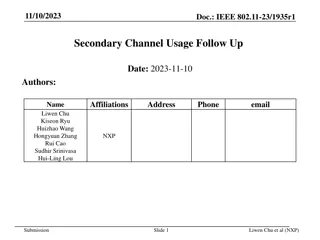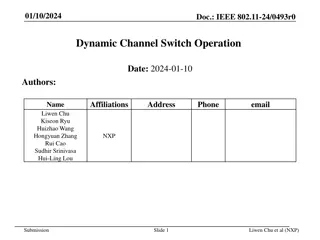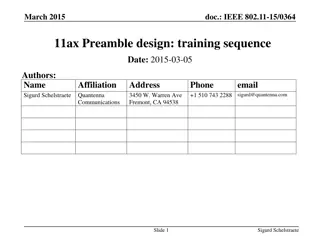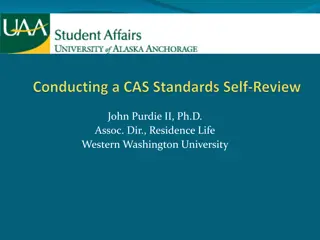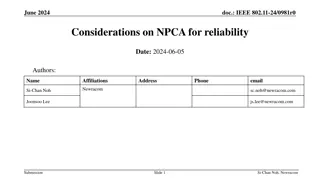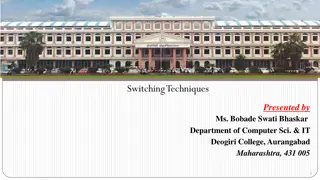Discussion on Channel Switching for NP-CAs in IEEE 802.11-24
This presentation delves into facilitating Non-Primary Channel Access (NP-CA) operations in IEEE 802.11-24 by enabling NP-CA STAs to predict OBSS traffic duration on the primary channel. It explores strategies to enhance NP-CA efficiency and performance through clearer prediction of operating durations for effective NP-CA operations.
Download Presentation

Please find below an Image/Link to download the presentation.
The content on the website is provided AS IS for your information and personal use only. It may not be sold, licensed, or shared on other websites without obtaining consent from the author.If you encounter any issues during the download, it is possible that the publisher has removed the file from their server.
You are allowed to download the files provided on this website for personal or commercial use, subject to the condition that they are used lawfully. All files are the property of their respective owners.
The content on the website is provided AS IS for your information and personal use only. It may not be sold, licensed, or shared on other websites without obtaining consent from the author.
E N D
Presentation Transcript
August 2024 doc.: IEEE 802.11-24/1404r0 Discussion on Channel Switching for NPCA Date: 2024-08-13 Authors: Name Affiliations Address Phone email Newracom Si-Chan Noh sc.noh@newracom.com Joonsoo Lee js.lee@newracom.com Submission Slide 1 Si-Chan Noh, Newracom
August 2024 doc.: IEEE 802.11-24/1404r0 Motivation Non-Primary Channel Access(NPCA) STAs may perform NPCA operation when the primary channel is BUSY due to OBSS traffic Predict/identify how long OBSS traffic will occupy the primary channel can affect NPCA efficiency and performance The duration for which OBSS traffic occupies the primary channel is beyond the control of NPCA STAs In this presentation, we discuss how to allow NPCA STAs to predict the NPCA operating duration more clearly for efficient NPCA operation Submission Slide 2 Si-Chan Noh, Newracom
August 2024 doc.: IEEE 802.11-24/1404r0 Recap[1-3] The following are the discussions so far on enabling NPCA STAs to perform NPCA operations [1-3] After detecting control frame exchange/OBSS PPDU Switch back to BSS primary channel before NAV expires/before the end of PPDU PPDU-based Switch back to the primary channel at the end of the OBSS PPDU SP-based Switch to a non-primary channel without switching back and forth during an OBSS SPs When the NPCA STAs detect OBSS traffic, it is required to identify necessary information more clearly for the NPCA operation Submission Slide 3 Si-Chan Noh, Newracom
August 2024 doc.: IEEE 802.11-24/1404r0 Channel Switching after detecting PHY preamble When NPCA STAs are enabled to perform NPCA operation after detecting OBSS PPDU(e.g., HE/EHT/UHR), it can perform NPCA through following information Based on preamble or Duration/ID field in MAC header In here, we assume that the NPCA STAs perform NPCA after detecting preamble of the OBSS PPDU where TXOP duration information can be provided If NPCA STAs can predict the duration that OBSS traffic occupies the BSS primary channel through TXOP duration, it can perform NPCA during that duration Data payload BA Preamble BSS Primary channel Switch back Channel switching TXOP duration (= may NPCA operating duration) Submission Slide 4 Si-Chan Noh, Newracom
August 2024 doc.: IEEE 802.11-24/1404r0 Channel Switching after detecting control frame exchange When NPCA STAs are enabled to perform NPCA after detecting control frame exchange (e.g., (MU)-RTS/CTS), it can perform NPCA through following information Based on Duration/ID field The NPCA STAs can predict the duration that OBSS traffic occupies the BSS primary channel through Duration/ID field and it can perform NPCA during that duration (MU)- RTS CTS BA DATA BSS Primary channel NAV set by (MU)-RTS NAV set by CTS Switch back Channel switching NAV duration (= may NPCA operating duration) Submission Slide 5 Si-Chan Noh, Newracom
August 2024 doc.: IEEE 802.11-24/1404r0 NPCA operating duration Through detecting PHY preamble/control frame exchange, the NPCA STAs can obtain NAV duration information that may imply the NPCA operating duration In some cases, this obtained NAV duration information may not clearly indicate the duration that OBSS traffic occupies the BSS primary channel For example, NAV duration can be defined for a fragmented MSDU, which does not indicate the actual/entire/desired TXOP duration It can be implementation dependent, but also beyond the control of NPCA STAs Submission Slide 6 Si-Chan Noh, Newracom
August 2024 doc.: IEEE 802.11-24/1404r0 NPCA operating duration However, from the perspective of NPCA STAs, the following situations may arise If the obtained NAV duration information is too short to perform NPCA, even though it may be possible in the long-term manner, channel switching might not be performed; or actual/entire/desired TXOP (HE/EHT/UHR) DATA 1 (HE/EHT/UHR) DATA 2 BA 1 BA 2 BSS Primary channel NAV set by (Data 1) NAV set by (Data 2) * for convenience, assume that NPCA STAs perform NPCA after detecting preamble of the OBSS PPDU Too short to perform NPCA Too short to perform NPCA Even though the NPCA operation can be performed continuously in the long-term manner, switching back and forth between BSS and NPCA primary channel can occur actual/entire/desired TXOP back (MU)- RTS (MU)- RTS CTS BA 1 CTS BA 1 DATA 1 DATA 1 BSS Primary channel NAV set by (MU)-RTS NAV set by CTS NAV set by (MU)-RTS NAV set by CTS Switch back Channel switching Channel switching Switch * for convenience, switching delay is omitted and second (MU)RTS/CTS can be excluded NAV duration NAV duration (= may NPCA operation duration) (= may NPCA operation duration) Submission Slide 7 Si-Chan Noh, Newracom
August 2024 doc.: IEEE 802.11-24/1404r0 Proposed approach for NPCA We can consider ways to convey the TXOP duration information more clearly to NPCA STAs Indicating the entire TXOP duration explicitly within UHR PPDU and/or ICF/ICR(e.g., (MU)-RTS/CTS) can be one approach This means that when allowing NPCA STAs to perform NPCA operation based on UHR PPDU and/or ICF/ICR, the indicated TXOP duration can be used for estimating the NPCA operating duration This approach can help prevent some scenarios discussed in the previous slide Submission Slide 8 Si-Chan Noh, Newracom
August 2024 doc.: IEEE 802.11-24/1404r0 Summary In this presentation, we discuss some approaches for NPCA STAs to predict the NPCA operating duration more clearly Including TXOP duration information in UHR PPDU and/or ICF/ICR(e.g., (MU)-RTS/CTS) Submission Slide 9 Si-Chan Noh, Newracom
August 2024 doc.: IEEE 802.11-24/1404r0 Reference [1] 24/0495r0, Non-Primary Channel Access (NPCA) - Follow up [2] 24/0496r1, Secondary Channel Usage Follow Up [3] 24/1259r0, SP-based non-primary channel access follow-up Submission Slide 10 Si-Chan Noh, Newracom
